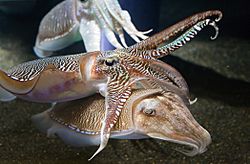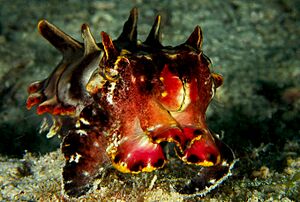Cuttlefish facts for kids
Quick facts for kids Cuttlefish |
|
|---|---|
 |
|
| Two cuttlefish interact while a third looks on. Georgia Aquarium | |
| Scientific classification | |
| Kingdom: | |
| Phylum: | |
| Class: | |
| Subclass: | |
| Superorder: | |
| Order: |
Sepiida
|
Cuttlefish are amazing ocean animals that belong to the group called Cephalopods. This means they are related to squid, octopuses, and the nautilus. They are all part of the Mollusc family, which also includes snails and clams.
Cuttlefish have a special internal shell called a cuttlebone. They also have big eyes, eight arms, and two long tentacles. These arms and tentacles have suckers with tiny teeth, which they use to grab their food.
Cuttlefish love to eat small molluscs, crabs, shrimp, fish, and even other cuttlefish. But watch out! sharks and bigger fish also like to eat them. Cuttlefish usually live for about 1 to 2 years.
Contents
Amazing Cuttlefish Body Parts
The Cuttlebone
Cuttlefish have a unique internal cuttlebone inside their bodies. It's made of calcium carbonate, which is the same material as chalk. This cuttlebone is full of tiny holes, making it porous.
The cuttlefish can change how much gas and liquid is in these holes. This helps them float up or sink down in the water, just like a submarine! Each species of cuttlefish has a cuttlebone with its own special shape and pattern.
People sometimes use cuttlebone. Jewelers and silversmiths use them as molds to make small metal objects. You might also see them given to pet birds as a good source of calcium. The cuttlebone is only found in cuttlefish, which makes them different from squid and other molluscs.
Changing Colors Like Magic
Cuttlefish are often called the "chameleons of the sea." This is because they can change their skin color incredibly fast! They can flash bright, colorful patterns to talk to other cuttlefish. They also use this amazing ability to camouflage themselves from predators. This helps them hide from animals that want to eat them.
How do they do this? Their skin has special groups of cells called chromatophores. These cells contain red, yellow, brown, and black pigments. Below these are other cells called iridophores and leucophores that reflect light. All these cells work together to change the cuttlefish's color in less than a second! There can be up to 200 of these special color cells in just one square millimeter of their skin.
Iridophores are like tiny mirrors made of chitin or protein. They reflect light, creating shiny metallic colors like blues, greens, golds, and silvers. Cuttlefish can use all these cells in many different combinations. Besides changing color, they can also change how light is polarized. This is a secret way they can signal to other animals that can "see" polarization.
Incredible Eyes
Cuttlefish eyes are some of the most advanced in the animal kingdom. They are very different from human eyes in how they grow. But they work in a similar way to help them see. This similarity between cuttlefish and human eyes is an example of convergent evolution. This means two different types of animals developed similar features independently.
Even though cuttlefish cannot see colors, they can see the polarization of light. This helps them see things with much better contrast. They have two special spots on their retina (the back of the eye) with lots of sensor cells. These are called fovea. One fovea helps them look forward, and the other helps them look backward. To change focus, they don't reshape their lenses like humans do. Instead, they reshape their entire eye!

Blue Blood
The blood of a cuttlefish is a strange green-blue color. This is because it uses a copper-containing protein called haemocyanin to carry oxygen. Human blood, and the blood of other vertebrates, is red because it uses an iron-containing protein called haemoglobin. Haemocyanin is not as good at carrying oxygen as haemoglobin.
Cuttlefish have three separate 'hearts'. Two of these hearts pump blood to the cuttlefish's two gills (one heart for each gill). The third heart pumps blood around the rest of its body.
Cuttlefish and Humans
Cuttlefish Ink
Like squid and octopuses, cuttlefish can squirt ink. This ink is a defense tool. When a cuttlefish feels in danger, it squirts out a cloud of ink to confuse its attacker. This gives the cuttlefish time to swim away and hide.
In the past, this ink was an important dye called sepia. People used it to color things. Today, most dyes are made artificially, so natural sepia ink is not used as much.
Cuttlefish as Food
Cuttlefish are caught and eaten in many parts of the world. They are popular in Mediterranean countries and in East Asia. While squid is more common in restaurants globally, dried cuttlefish is very popular in East Asia.
In Italy and Croatia, cuttlefish is used in a dish called Risotto Nero. "Nero" means 'black' in Italian. The rice in this dish turns black because of the cuttlefish ink! Spanish cooking also uses cuttlefish and its ink. It adds a rich marine flavor and smooth texture to dishes like rice, pasta, and fish stews.
Cuttlefish in Books
Cuttlefish even appear in famous books! One important example is a collection of poems by Eugenio Montale called Cuttlefish Bones (Ossi di seppia). This book was published in Italy in 1925. Eugenio Montale later won the Nobel Prize in Literature in 1975 for his writing.
Cuttlefish Family Tree
There are over 120 different species of living cuttlefish. They are grouped into 5 main genera. Seven species belong to the Sepiadariidae family, and all the others are in the Sepiidae family.
- CLASS CEPHALOPODA
- Subclass Nautiloidea: nautilus
- Subclass Coleoidea: squid, octopus, cuttlefish
- Superorder Octopodiformes
- Superorder Decapodiformes
*Suborder Sepiina **Family Sepiadariidae **Family Sepiidae
Images for kids
-
Sepia latimanus, East Timor
-
The common cuttlefish (Sepia officinalis) is the best-known cuttlefish species
-
Engravings by the Dutch zoologist Albertus Seba, 1665–1736
See also
 In Spanish: Sepia para niños
In Spanish: Sepia para niños













